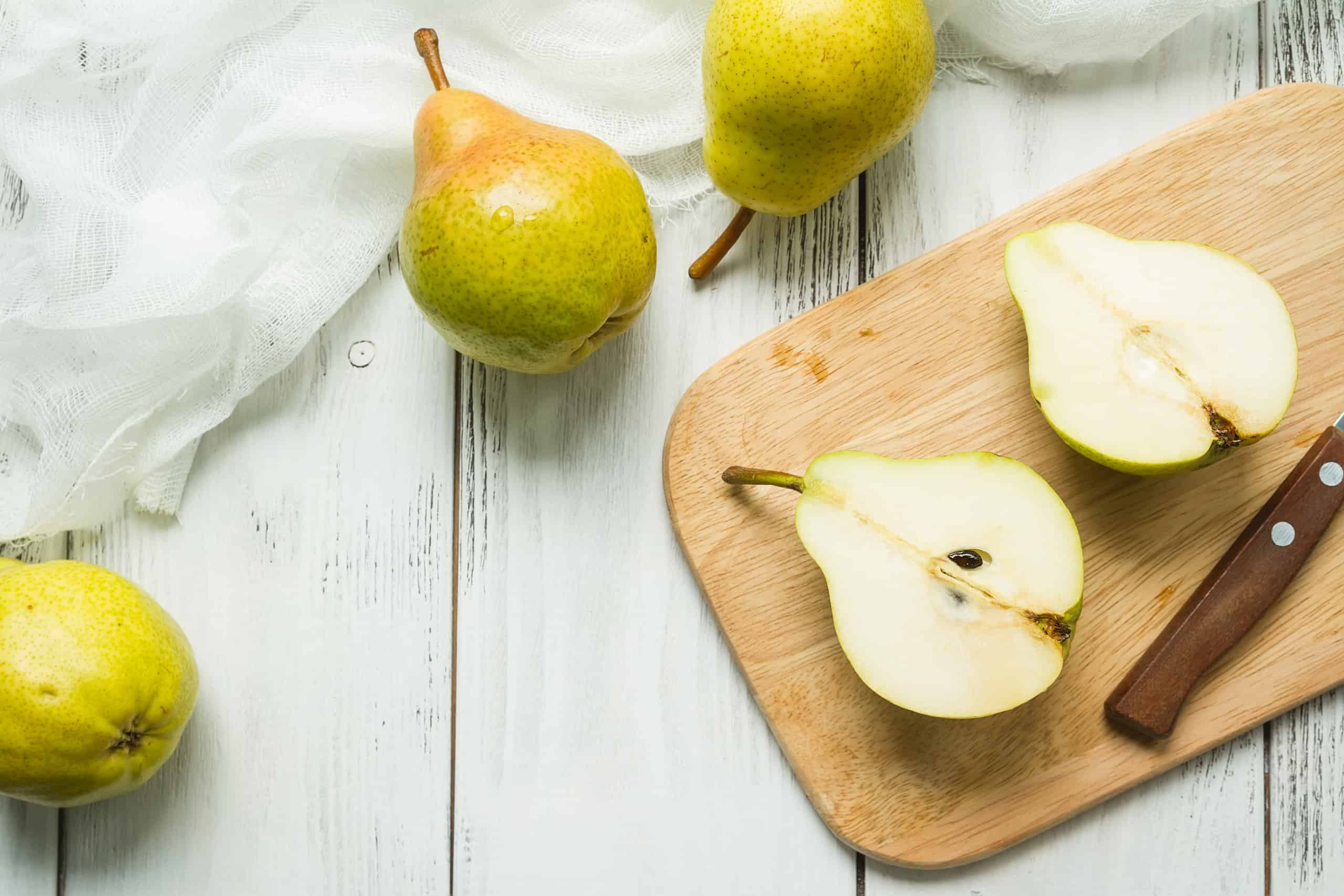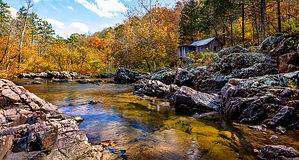When you think of produce, you may conjure images of fruits thriving in warm temperatures and bright sunshine, but the pear is a different story. Of course, pears do need sunlight, but these fruits often grow best in cool, rainy climates.
They are frequently harvested toward the end of the summer, in the fall, and all the way through some of the winter months. In this article we will examine some of the country’s most common pears, their flavors, and when these fruits are at their peak.
Where Are Pears Grown in the United States?
Six main states in the U.S. produce pears: California, Michigan, New York, Oregon, Pennsylvania, and Washington. Out of these states, Washington and Oregon are responsible for producing around 87% of the nation’s pears. Add California and you have around 95% of the country’s pear production.
In general, peak pear season takes place in late summer and mid-fall. However, not all species of pears prefer the same climate and some varieties are in peak season well into the winter months. Ten common species of pears grow in the United States, each with a distinctive flavor.
How to Tell Whether a Pear Is Ripe
Determining whether or not a pear is ripe is an important part of getting the juiciest and sweetest fruit. One of the main methods, recommended by USA Pears is known as the “Check the Neck” test.
This involves applying gentle pressure to the neck of the pear. If it gives way, the fruit is ready. A few varieties of pears also change colors as they ripen. One way to slow down the process of ripening pears is by keeping them in the refrigerator.
Pear Tree Pests
Humans aren’t the only species who enjoy a juicy pear. Several insects can cause a problem for those growing the fruits, including the paper-leaf blister mite, pear fruit sawfly, and spider mites. Two of the worst insects to infest pear trees are the coddling moth and pear psylla.
Coddling Moth
According to a fact sheet from Utah State University, coddling moths commonly infest apples and pears, by laying their eggs on or near the fruits.
Larvae then bore into the fruits to eat their flesh and seeds. Signs of an infestation of these larvae include small holes in the fruit and a sawdust-like material on the outside, which is actually the pest’s excrement.
Pear Psylla
The pear psylla employs a similar tactic to the coddling moth. In the spring they lay their eggs on buds and leaves of pear trees and their nymphs feed on the leaves and fruit. Even worse, pear psylla may also transmit a disease known as “pear decline” that can slowly kill pear trees over the years.
Pear psylla that infest a tree leave behind a sticky honeydew residue that helps identify the problem. An infected pear tree might also have leaves with a strange “scorched” appearance.
Pear Season by Variety
An estimated 3,000 varieties of pears grow throughout the world. Thanks to modern-day conveniences, we can pick up pears at a local grocery store that originated thousands of miles away. In this article, we will examine the types of pears frequently grown in the United States and when they are at their peak season. We will also examine the unique flavors and textures of these fruits.
Anjou
Anjou pears are some of the most commonly produced in the States. There are two varieties of Anjou — red and green. Both reach their peak season from October to July, according to USA Pears. The best way to determine whether an Anjou pear is ripe is to apply gentle pressure near the fruit’s stem.
Green Anjou pears are more common than the red variety. They have a round shape and are juicy and sweet with a touch of citrus. Red Anjou pears have a similar flavor and shape while being slightly tangier.
Interestingly, red Anjous are actually a “bud sport” found on green anjou trees. Bud sports occur when crops on trees undergo a random and naturally occurring transformation, such as a change in color. The first instance of red Anjou was discovered in Oregon in the 1950s.
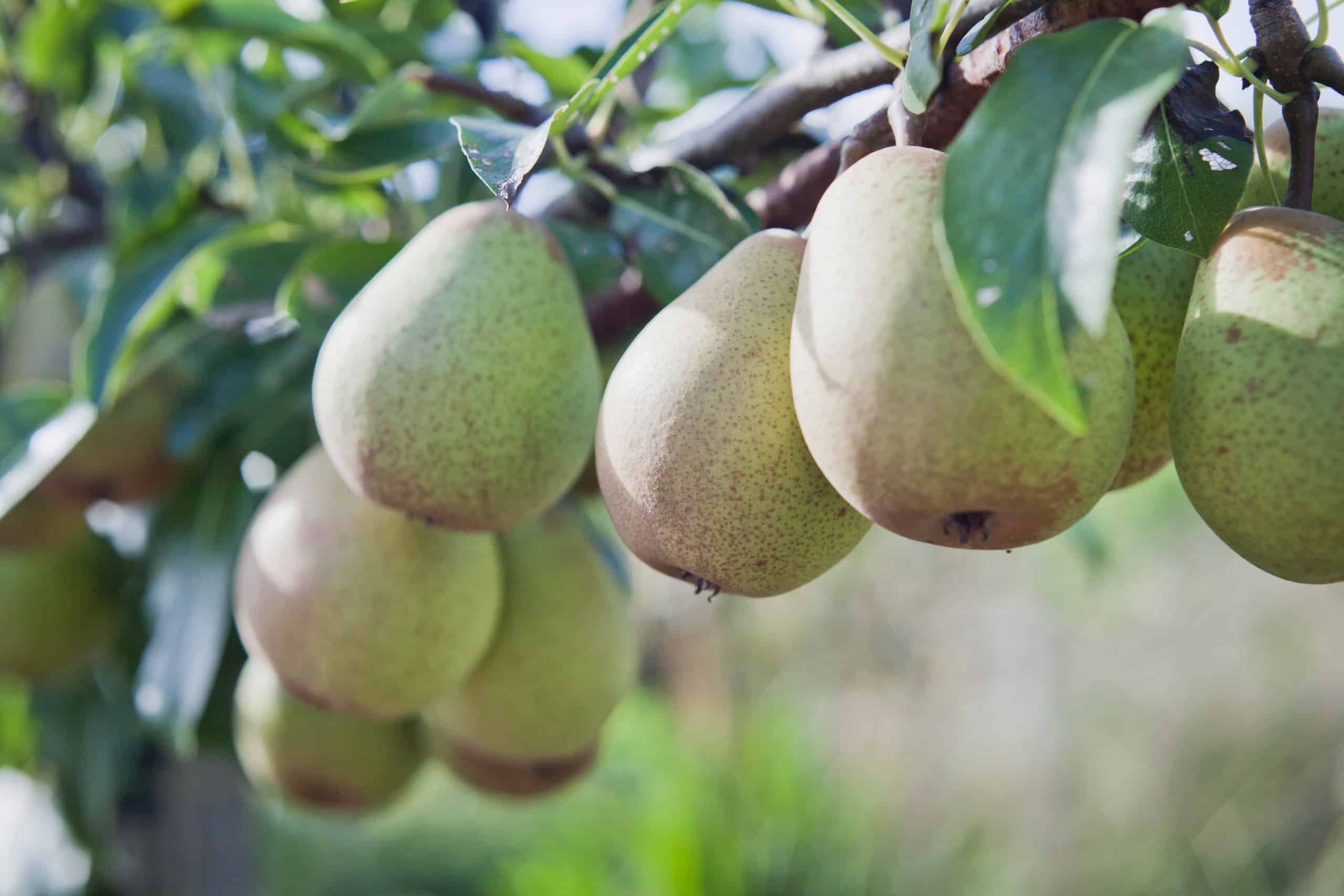
Anjou pears have a distinctive round shape and are green or red in color.
©JoannaTkaczuk/Shutterstock.com
Bosc
Boscs are another commonly produced pear in the United States. These varieties are slender with a long neck and stem. They are earthy brown in color and have a distinctive honey-sweet flavor with hints of woodsy spice.
Bosc trees thrive in the Pacific Northwest and reach their peak season from September to April. The pears can be enjoyed earlier in the ripening process than other varieties. You can determine whether a bosc pear is ripe by pressing on the neck of the fruit.
Bartlett
Like the Anjou pear, Bartletts have two varieties. The most common Bartlett pear has a “yellow” or “golden” color. Bartletts also have a red variety, which like the red Anjou is a “bud sport.”
Bartlett pears are sweet, soft, and juicy and are an ideal pear for canning and cooking. Yellow Bartletts are in season between August and February. Red Bartlett season is a little shorter and ends in December.
Yellow Bartlett’s ripeness can be determined by its color. These varieties are crunchy and tart when their skin is green and become more sweet and juicy as the skin yellows.
According to Epicurious Magazine, Bartlett pears are one of the oldest pear varieties in the United States. They were first developed in the late 1700s, back when they were commonly known as the Williams pear.
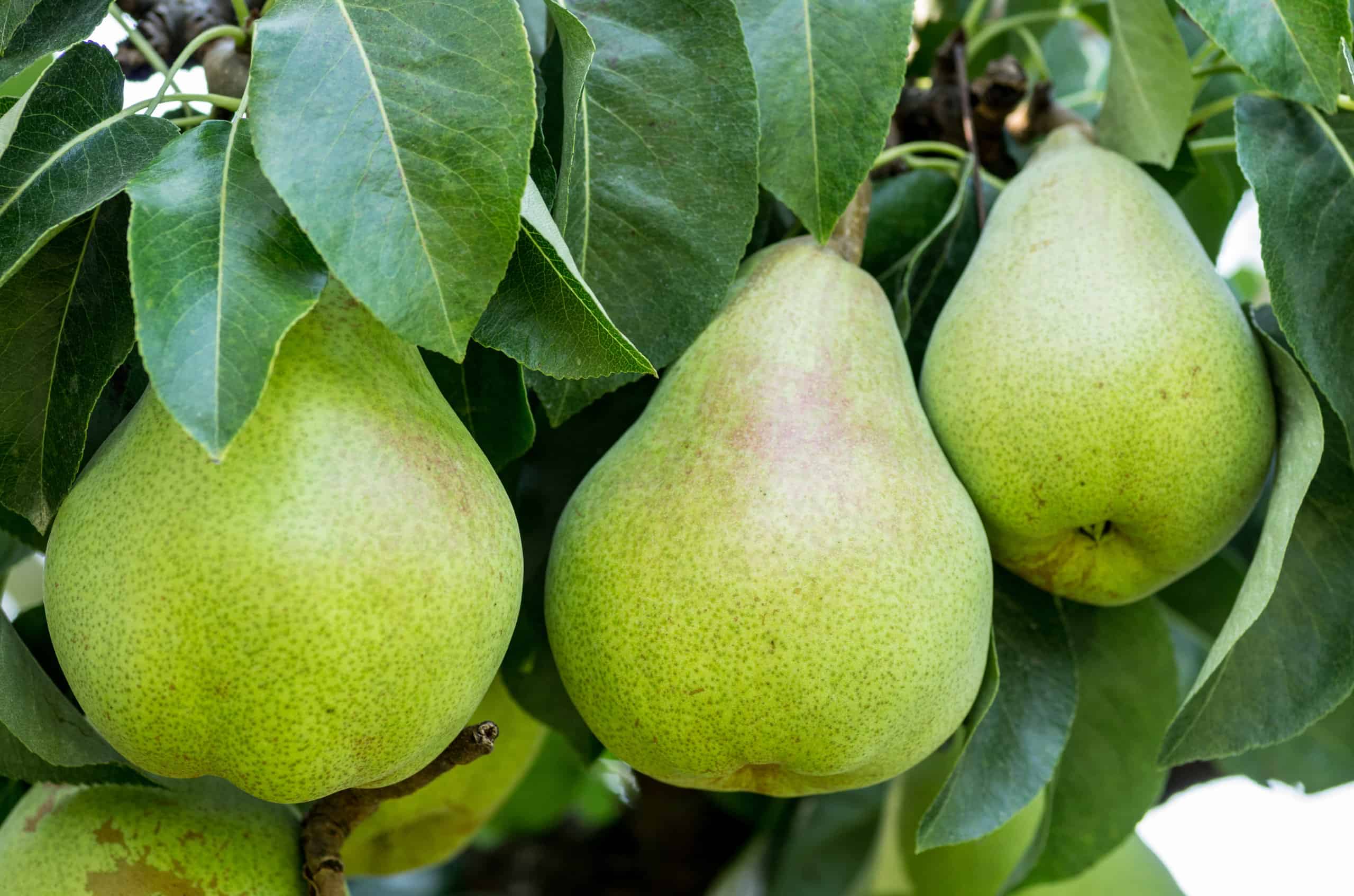
Bartlett pears turn yellow as they ripen.
©Zigzag Mountain Art/Shutterstock.com
Comice
Comice pears are known for being buttery, juicy, and very sweet. They are rotund green pears, often with a red blush covering areas of the skin. They are in season from September to February.
Comice pears may turn slightly yellow as they ripen, but the best way to tell whether they are ready to eat is by pressing on the neck. It’s also worth noting that Comice pears have very fragile skin and bruise easily.
Concorde
Concorde pears are another exceptionally sweet variety, though they tend to be more crisp than juicy with a distinct vanilla flavor. These features make Concorde pears popular in a variety of culinary uses.
They have a distinctive long and elegant shape and are usually green in color. Concorde pears are actually a cross between two pear varieties — the Conference and Comice.
Concorde pears are in season from September to December. They have a more crisp flavor earlier in the ripening process and change color only slightly when they are fully ripe.
Forelle
Forelle pears are a smaller variety with a bell shape and short neck. They are typically green and red with unique freckling all over the skin. They are a crisp, tangy, and refreshing fruit. However, Forelle pears have one of the most limited crop sizes in the U.S.
Unlike many pears, Forelles change color as they ripen. The pear’s red freckling remains visible as the underlying green skin turns from green to yellow. Forelle season is from September to January and they are certainly worth trying for those who have never experienced these sweet gems.
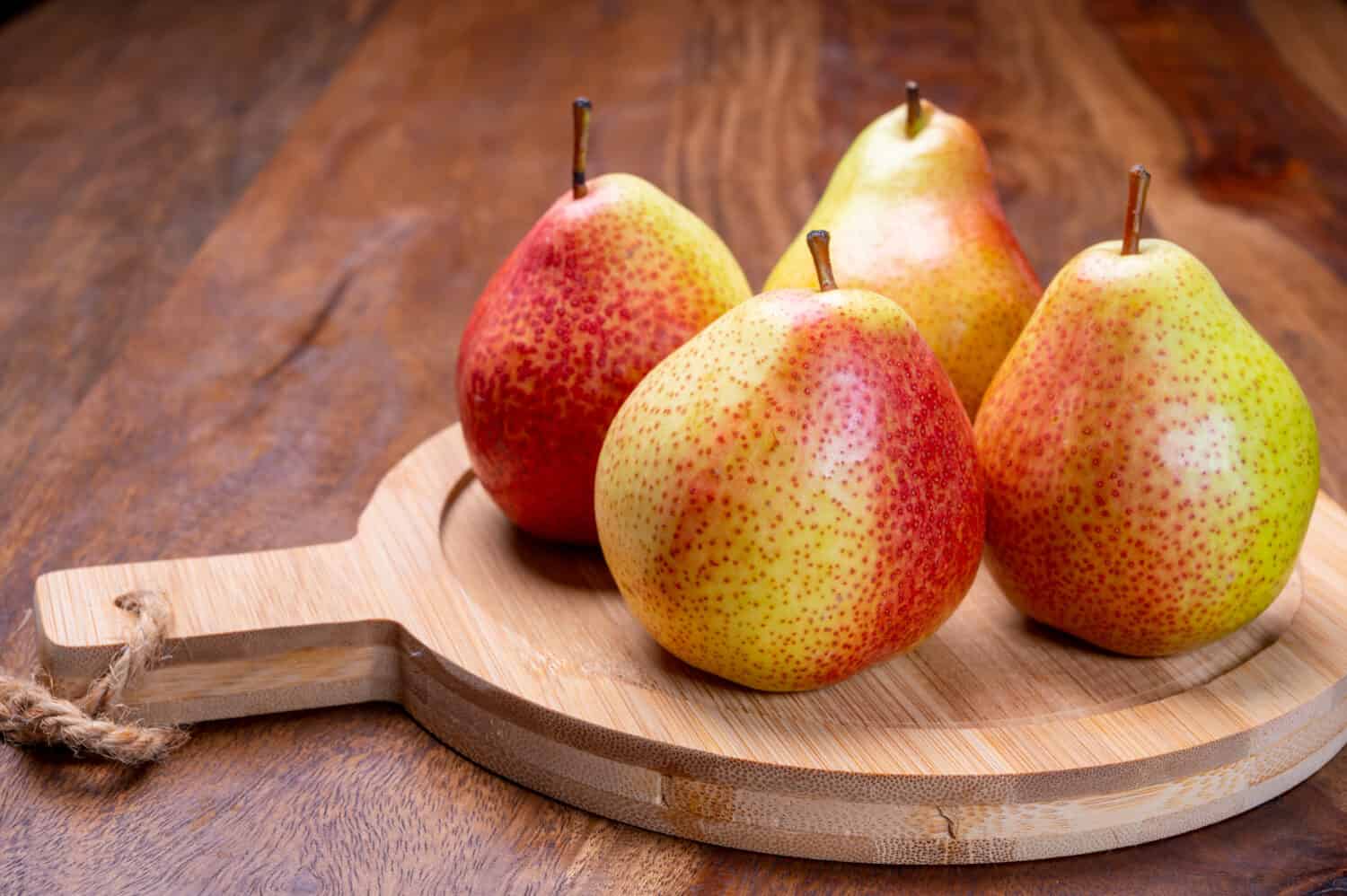
Forelle pears have a beautiful red freckling known as “lenticels.”
©barmalini/Shutterstock.com
Seckel
Seckel pears are the smallest widely grown variety in the United States. They are bite-sized, sweet, and crunchy, making seckel pears an ideal snack.
Seckel pears, sometimes called sugar pears, are olive green and often develop a deep red blush that may cover the entire fruit. These pears are in season from September to February. They do not change color when ripening, but the neck test works to determine ripeness.
All of the pears mentioned so far on this list originally came to the U.S. from European cultivars. However, the seckel pear may be a different story. They are believed to have been discovered in Philadelphia in the early 1800s, though this is not confirmed.
Starkrimson
Starkrimson pears stand out thanks to their brilliant crimson color. Their shape is similar to a Bartlett pear. These varieties are sweet, tart, and incredibly juicy. They are in season from August to November and are one of the first varieties available at the start of pear season.
Starkrimsons are one of the rare varieties of pear that change color as they ripen. Their color shifts from deep crimson to bright red crimson when they are ready to eat. Starkrimson pears also give off a floral aroma as they ripen.
As we’ve discussed in this article, red pears are actually a naturally occurring mutation from varieties of green pears. Many years ago, the same thing occurred with the Starkrimson. The variety was discovered in Missouri growing from a Clapp’s favorite pear tree.
Stark Brothers Nursery then bred the fruit for many years. Today the Starkrimson pear grows in the Pacific Northwest and is popular in markets throughout the country.
Asian Pear
As the name suggests, Asian pears did not originate in the U.S. In fact, most of the varieties on this list were actually first discovered and grown outside the states. Asian pears originated in China and Japan and have been growing in Asian nations for thousands of years.
According to Auburn University, records indicate that Chinese immigrants introduced the fruit to the United States in the 19th century. Today Asian pears are grown in California, Oregon, and Washington. They are typically more expensive than European varieties of pears because they are more difficult to grow.
Asian pears are typically ready to eat right when they are picked. Their ripening period begins in mid-July and can last all the way to September in some areas. Asian pears store well in the refrigerator for up to three months.
Unlike many other varieties of pear, Asian pears do not become softer and juicier with time. These fruits are meant to be crisp, almost like an apple. They typically have a rounded shape and golden color when ready to eat. Asian pears are sweet, tart, and crunchy with a unique flavor.
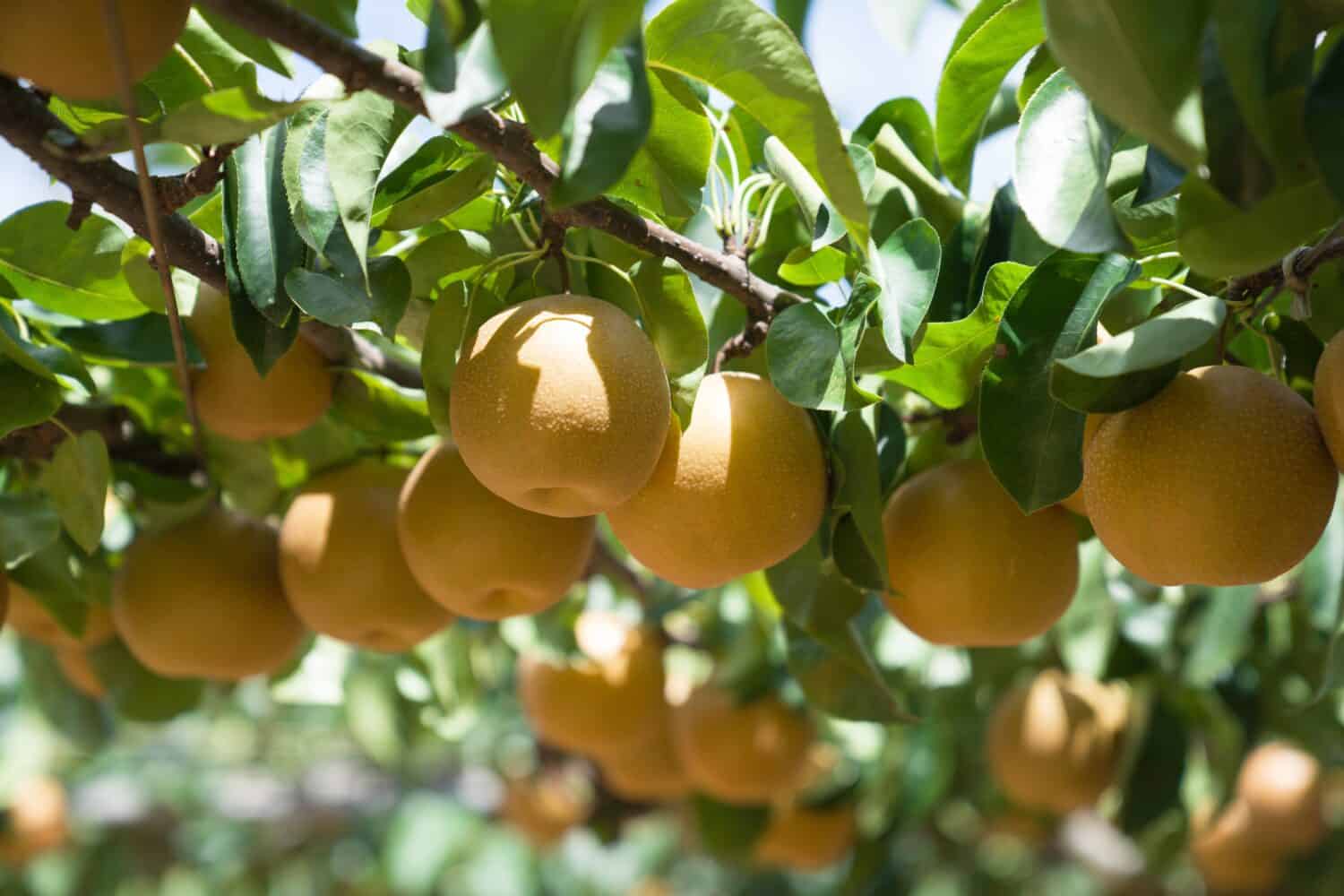
Unlike many of their European counterparts, Asian pears are ready to eat right after they are picked.
©Nikox2/Shutterstock.com
Summary of Pear Varieties Peak Season
| Pear Variety | Peak Season | Region Grown |
|---|---|---|
| Anjou (Green/Red) | October – July | Pacific Northwest, New York, Michigan |
| Bosc | September – April | Pacific Northwest, California New York, Michigan |
| Bartlett (Yellow/Red) | August – December/February | Pacific Northwest, California, New York, Michigan |
| Comice | September – February | Oregon, California |
| Concorde | September – December | Washington |
| Forelle | September – January | Pacific Northwest, California |
| Seckel | September – February | Pennslyvania, California |
| Starkrimson | August – November | Pacific Northwest |
| Asian pear | July-September | Pacific Northwest, California |
Thank you for reading! Have some feedback for us? Contact the AZ Animals editorial team.

